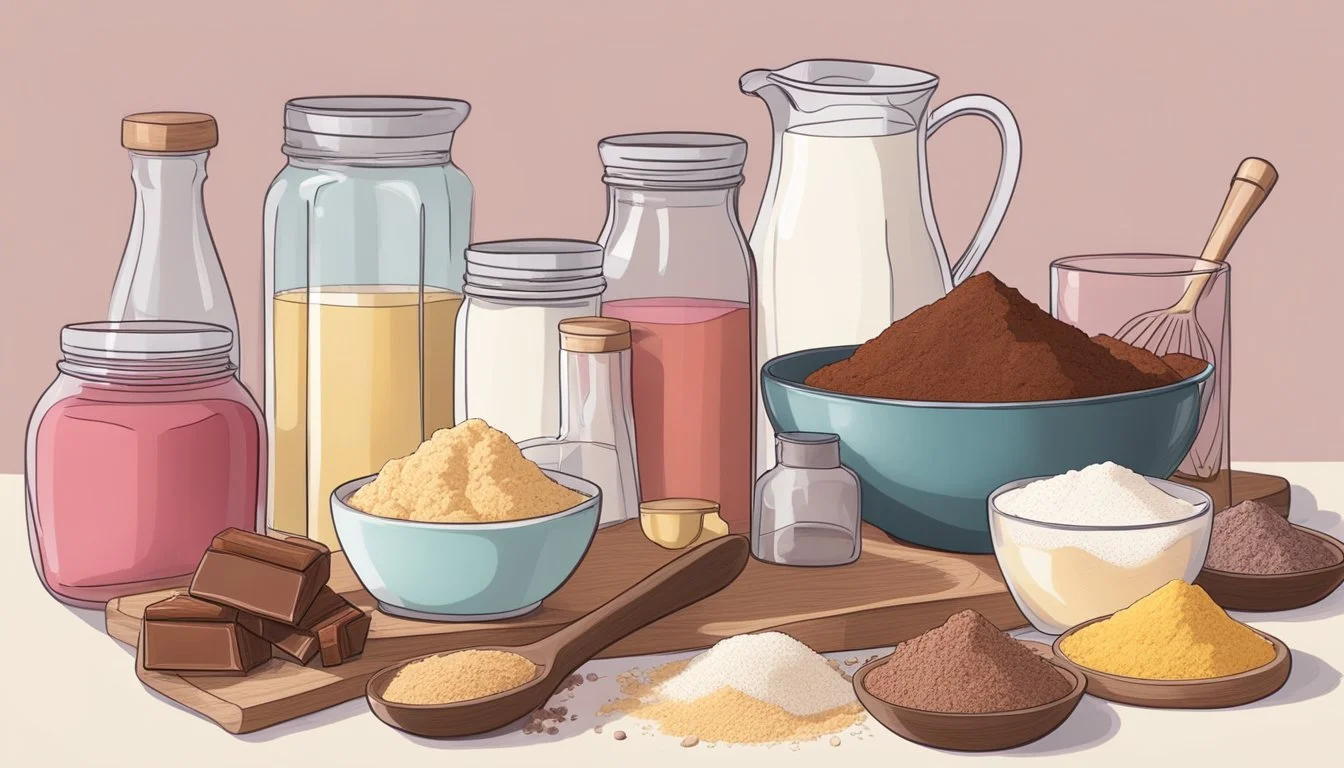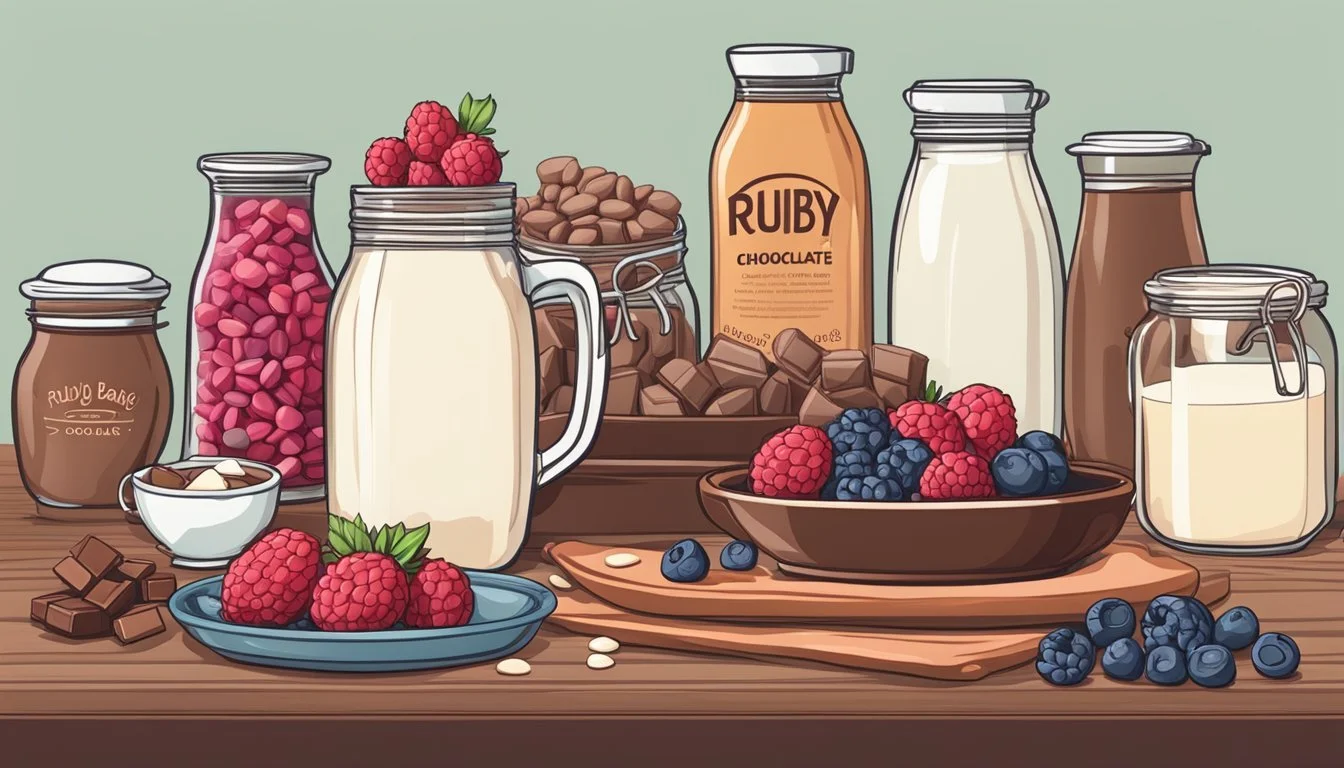Ruby Chocolate Substitutes
Top Alternatives for Unique Recipes
Ruby chocolate, with its vibrant pink hue and tart berry-like flavor, has captivated dessert enthusiasts worldwide. Whether you're unable to find it or simply looking for alternatives, there are several viable substitutes that can achieve similar results in your recipes. White chocolate, given its mild sweetness and creamy texture, often serves as the most straightforward replacement.
For those looking to replicate the unique tartness of ruby chocolate, a combination of white chocolate and a small amount of citric acid can come close. Alternatively, you can use white chocolate combined with freeze-dried raspberry powder to introduce a natural berry flavor and color. Dark and milk chocolate are less suitable substitutes due to their distinct flavor profiles and lack of comparable tartness.
Experimenting with these substitutes can help you achieve delicious and visually appealing desserts even when ruby chocolate is out of reach. These alternatives offer a versatile approach to maintaining the unique qualities of your confections.
Understanding Ruby Chocolate
Ruby chocolate, a notable innovation in the chocolate world, was developed by Barry Callebaut. Its unique flavors and aromas distinguish it from other chocolates. This section explores its origin, composition, and distinctive sensory characteristics.
Origin and Composition
Ruby chocolate was introduced by Barry Callebaut in 2017. It is crafted from ruby cocoa beans, which are mainly sourced from Ecuador, Brazil, and Ivory Coast. These beans undergo a special fermentation process. This method is crucial in unlocking the beans' unique properties without the need for added colorants or flavorings.
The composition includes cocoa butter, milk powder, and sugar, similar to milk chocolate. However, the defining factor lies in its natural reddish-pink hue. The color and taste are both derived from the specific treatment of the ruby cocoa bean during processing. This chocolate also boasts a rich amount of antioxidants, adding to its health appeal.
Unique Flavors and Aromas
Ruby chocolate is celebrated for its distinctive flavor profile. Unlike dark or milk chocolate, it presents a unique fruity tang with berry-like notes. This tartness is balanced with a smooth creaminess, offering a novel taste experience.
The aroma of ruby chocolate is equally unusual, often described as having hints of red berries and a slight acidity. This combination of taste and smell makes it a versatile ingredient in culinary applications, adding complexity to both sweet and savory dishes. The high pH levels contribute to its sensitive nature, making it more challenging to temper and work with compared to traditional chocolates.
Common Ruby Chocolate Alternatives
When Ruby chocolate isn't available, there are several alternatives that can replicate its unique taste and texture. This section explores various options that range from white and milk chocolates to plant-based substitutes.
White Chocolate Variations
White chocolate is a common alternative due to its mild flavor and creamy texture. It can be tinted with natural food colorings to mimic the pink hues of Ruby chocolate. Adding a small amount of citrus or berry essence can enhance its fruity notes.
Key Points:
Mild flavor and creamy texture
Can be tinted and flavored for similar appearance and taste
Easily found in most grocery stores
Milk and Dark Chocolate
Milk chocolate can serve as a substitute, especially in recipes where a richer, creamier texture is desired. It has a sweeter taste compared to dark chocolate but lacks Ruby's distinct berry flavor. Dark chocolate, while more intense and less sweet, can be blended with milk chocolate to balance flavors.
Key Points:
Milk chocolate offers a creamy, sweet alternative
Dark chocolate provides a richer, less sweet option
Blending both can help achieve a balanced flavor profile
Plant-Based and Specialty Substitutes
Vegan chocolate and carob powder are excellent alternatives for those avoiding dairy. Vegan chocolate often uses coconut milk and other plant-based ingredients to mimic the creaminess of Ruby chocolate. Carob powder offers a naturally sweet, earthy flavor and works well in baked goods.
Key Points:
Suitable for those with dietary restrictions
Coconut milk in vegan chocolate imitates creamy textures
Carob powder provides a sweety and earthy alternative
These substitutes offer a range of flavors and textures, accommodating various dietary needs and preferences.
Substitute Characteristics
When choosing substitutes for Ruby chocolate, consider flavor profiles, color considerations, and nutritional content.
Flavor Profiles
Substitutes often aim to replicate Ruby chocolate's unique taste, blending fruity notes with a slightly tart finish.
White chocolate mixed with berry powders can approximate the tartness and sweetness. Carob offers a different, more earthy flavor, while milk chocolate enhanced with fruit extracts can provide some similarity.
The addition of ingredients like citrus zest or natural berry flavorings helps to mimic the distinctive ruby taste, albeit not perfectly. Substitutes should strive for a balance between tart and sweet to match the original's complexity.
Color Considerations
Ruby chocolate's pink hue is a signature feature. Achieving this with substitutes involves creative use of natural colorants.
Beetroot powder or red berry powders (like strawberry or raspberry) are commonly used. These ingredients blend well with white chocolate to achieve a visually appealing pink color. Pitaya (dragon fruit) powder is another alternative, offering vibrant pigmentation without alteration in taste. It's critical these colorants do not overpower the substitute's flavor.
Nutritional Content
The nutritional makeup of Ruby chocolate includes components like cocoa butter, sugar, and milk solids. Substitutes must aim to replicate this blend.
Substitutes often combine white chocolate with fruit powders. While carob and milk chocolate provide different nutrient profiles, they offer similar cocoa butter content. Sweeteners must be adjusted to retain a balanced sugar level.
Substitutes should have comparable fat content from cocoa butter and carbohydrates from sugar. Keeping these nutritional elements in check ensures a closer match to Ruby chocolate's properties.
Ingredients and Baking Considerations
When substituting ruby chocolate in baking, it's crucial to choose the right ingredients that will complement or closely mimic its unique tart and fruity flavor, while also considering the texture and final appearance of your baked goods. Below are some of the key points to keep in mind regarding different ingredient substitutes.
Chocolate Chips and Chunks
Ruby chocolate has a distinctive taste and texture that can be challenging to replicate. When using chocolate chips and chunks as substitutes, consider the following options:
White Chocolate Chips or Chunks: These provide a neutral base that can be flavored with freeze-dried raspberry powder to approximate the tartness of ruby chocolate.
Milk Chocolate Chips: To mimic the creaminess of ruby chocolate, combining milk chocolate chips with a small amount of citric acid or fruit powder can work well.
Dark Chocolate Chunks: For a less sweet option, dark chocolate with fruit flavors added can also serve as a substitute, though the resulting flavor will be less creamy.
Adapting the composition and proportion of these ingredients can help achieve a similar mouthfeel and flavor profile, keeping in mind the sweetness, tartness, and melting point during baking.
Cocoa Powders and Solids
When replacing ruby chocolate with cocoa powders and solids, it is essential to adjust other recipe components to maintain texture and taste balance:
Cocoa Powder: Use high-quality cocoa powder combined with sugar and a fruity acid, like citric acid or freeze-dried fruit powder, to replicate ruby chocolate’s flavor.
Carob Powder: This can offer a slightly different sweetness and texture and is often combined with a fruit puree or extract to mimic ruby chocolate’s complexity.
These substitutes necessitate adjusting liquid and fat content. For instance, combining 3 tablespoons of carob powder with a tablespoon of oil can help simulate the chocolate's smoothness.
Experimenting with these combinations can yield a satisfactory substitute while abiding by the recipe’s structural requirements. Balancing flavors and textures thoughtfully can result in a successful baking outcome.
Recipes Involving Ruby Chocolate
Ruby chocolate offers a unique taste and color that can elevate various recipes, ranging from desserts to beverages. Below, key recipes showcase how to incorporate this vibrant chocolate into delightful culinary creations.
Dessert Recipes
Ruby Chocolate Truffles: These truffles are a simple yet decadent way to enjoy ruby chocolate. Combining cream and cookie crumbs with a quick mixing and cooling process, the truffles are rolled into bite-sized balls and powdered with icing sugar and pink drink powder.
Ruby Chocolate Blondies: For a chewy, sweet treat, ruby chocolate blondies provide an excellent option. Flour and kosher salt are whisked together in a medium bowl. Butter and chopped ruby chocolate are melted in a double boiler, stirred until combined, then mixed into the dry ingredients before baking.
Small Batch Ruby Chocolate Truffles: With a preparation time of about two hours, small batch ruby chocolate truffles involve freezing the truffle mixture for one hour. Then, these chilled balls are dipped in melted semi-sweet chocolate and left to harden on wax paper, creating a delightful contrast between the rich chocolate coating and ruby chocolate center.
Beverage Applications
Hot Ruby Cocoa: A twist on traditional hot cocoa, this beverage utilizes melted ruby chocolate mixed with hot milk and a dash of vanilla extract. The result is a creamy, slightly fruity hot cocoa that pairs perfectly with a cold day.
Ruby Chocolate Cocktails: Ruby chocolate can add a unique flair to cocktails. For example, incorporating melted ruby chocolate into an espresso martini can create a visually stunning and flavorful drink. Another option is a ruby chocolate-infused cream liqueur, which can be served on the rocks or mixed into other beverages for a distinctive twist.
Ruby Chocolate Milkshake: Blend ruby chocolate with ice cream and milk to create a vibrant milkshake. Topped with whipped cream and chocolate shavings, it becomes a refreshing and visually appealing drink ideal for summer.
These recipes demonstrate the versatility of ruby chocolate in various culinary contexts, offering both traditional and innovative uses for this captivating ingredient.
Substitution Tips and Techniques
When using substitutes for Ruby chocolate, it’s essential to consider the impact on taste and texture. Knowing the right methods and ingredients can significantly improve the outcome.
Baking and Cooking Methods
For baking, using a double boiler is an effective way to gently melt chocolate substitutes. This ensures the substitute maintains a smooth texture and does not burn. If replacing Ruby chocolate with baking chocolate, note that baking chocolate lacks sweetness, so you may need to add sugar.
When substituting Ruby chocolate in recipes, try using white chocolate with a bit of fruit puree (like raspberry) to mimic the fruity notes. Wrapping cookies baked with these substitutes in parchment paper helps preserve freshness.
Adjust the baking temperature slightly lower if the substitute chocolate contains more sugar, which can caramelize quickly. Taste testing the mixtures before finalizing the recipe ensures a more accurate flavor match.
Influences on Chocolate Preferences
Several factors shape people's preferences for different types of chocolate, including geographical origin and evolving consumer trends. The influence of origins, cultural differences, and shifting market trends play significant roles in determining what types of chocolate are favored by different groups.
Geographical Impact on Chocolate Choices
Regional differences greatly affect chocolate preferences. In the U.S., milk chocolate is particularly popular due to its smooth, sweet flavor. Meanwhile, dark chocolate is more commonly chosen in Europe, reflecting higher cacao standards and a preference for less sweet options.
Japan's market demonstrates a unique inclination towards novelty chocolates such as matcha-flavored and ruby chocolates. The focus on innovation and culinary tradition drives these preferences.
In the Ivory Coast, the world's largest cocoa producer, local consumption is low, with most cocoa beans being exported. However, the quality and characteristics of Ivorian cocoa significantly influence global chocolate products. Understanding local origins, ingredients, and cultural context is key to decoding chocolate preferences.
Trends in Consumer Chocolate Consumption
Consumer chocolate consumption trends are constantly changing. A significant rise in health consciousness has led to an increased demand for dark chocolate, which is perceived as healthier due to its higher cocoa content and lower sugar levels.
Interest in specialty chocolates, such as ruby chocolate, has grown. Ruby chocolate, introduced by Barry Callebaut, offers a new taste experience and is popular among those seeking variety.
Fair trade and ethically sourced chocolates are also gaining traction, driven by consumer awareness of sustainability practices. Modern consumers often check the origins of their chocolate, favoring brands that support fair labor practices.
Changes in dietary habits and ethical concerns are reshaping the chocolate market, making it more diverse and dynamic than ever before.
Health Aspects of Chocolate Substitutes
Choosing the right substitute for ruby chocolate not only affects taste but also impacts health. Key aspects to consider are antioxidant levels and caloric and sugar contents.
Antioxidant Levels
Antioxidants play a crucial role in protecting the body from damage caused by free radicals. Dark chocolate and cacao nibs are noted for their high antioxidant content, primarily flavonoids. Dark chocolate with a high cocoa content can offer similar benefits.
List of high-antioxidant substitutes:
Cacao nibs: Derived from pure cacao beans, contain dense antioxidants.
Dark chocolate (70% or higher): Rich in flavonoids, essential for heart health.
Contrarily, milk chocolates or white chocolates exhibit lower antioxidant levels due to added milk solids and sugars, diluting the beneficial compounds.
Caloric and Sugar Contents
When substituting ruby chocolate, caloric and sugar content should be carefully evaluated. Alternatives such as dark chocolate typically have lower sugar and higher cocoa, which results in fewer calories derived from sugars.
Comparison of caloric content:
Dark chocolate: Lower in sugar, balanced calories.
White chocolate: Higher in sugars, adding to the caloric load.
Consuming chocolates with high sugar content can impact blood sugar levels and contribute to health issues such as obesity and diabetes. Opting for low-sugar options, such as cacao nibs, helps manage caloric intake more effectively.
In conclusion, choosing substitutes with higher antioxidants and responsible caloric content supports better health outcomes compared to sugary chocolates.
The Market for Ruby Chocolate and Its Substitutes
Ruby chocolate is a relatively new entrant in the chocolate world, notable for its unique color and flavor. Its market presence has prompted various brands to introduce substitutes and unique forms like ruby chocolate chips.
Commercial Availability
Since its introduction in 2017 by Barry Callebaut, ruby chocolate has seen a slow but steady rise in availability. Supermarkets and specialty stores have started stocking ruby chocolate, though it is still less prevalent than milk, dark, or white chocolate.
This chocolate is also beginning to appear in various formats: bars, ruby chocolate chips, and ruby-covered snacks. Major retailers like Amazon and select gourmet shops provide consumers with easier access to products containing ruby chocolate, broadening its market reach.
Brand Varieties
Several brands have launched products featuring ruby chocolate. Notable examples include Nestlé's Kit Kat and Magnum ice creams. Nestlé introduced Kit Kat Ruby, a variant that capitalizes on the chocolate's unique appearance and taste.
Magnum has also added ruby chocolate to its indulgent ice cream bars, enhancing the product lineup. Moreover, artisanal brands and chocolatiers around the world experiment with ruby chocolate, creating exclusive treats that cater to niche markets.
The varied offerings from both mass-market and specialty brands ensure that ruby chocolate continues to grow in popularity and consumer recognition.










